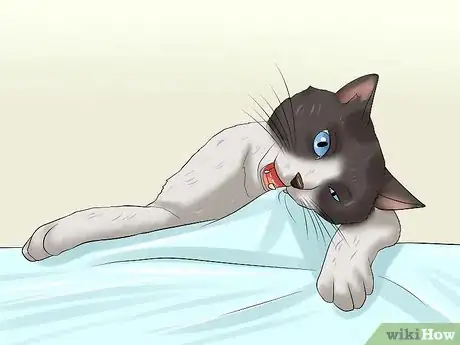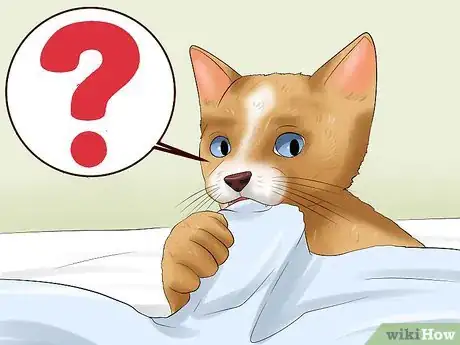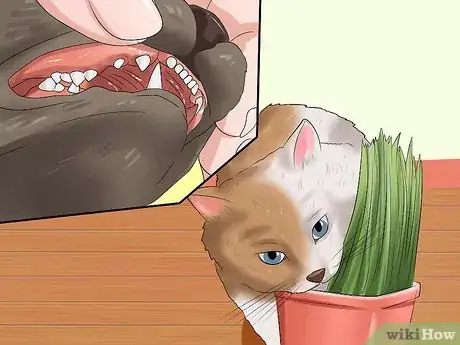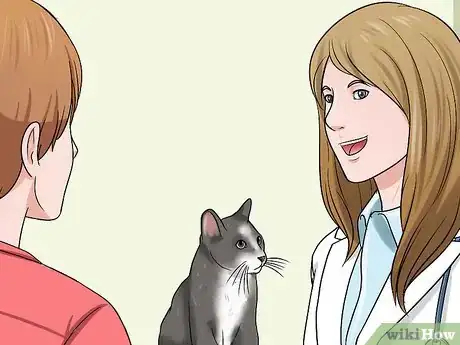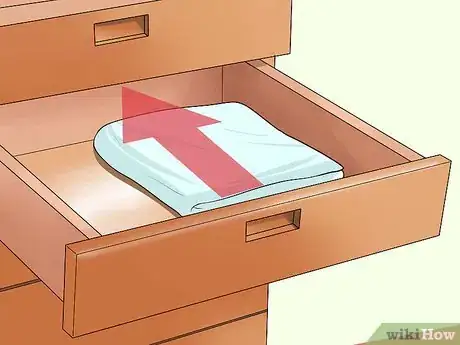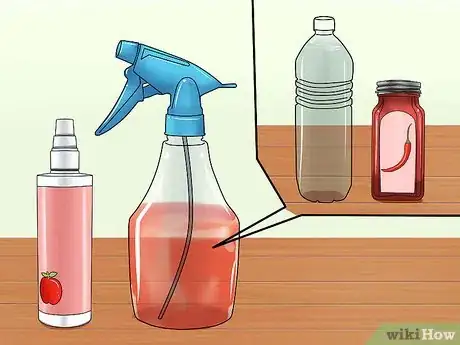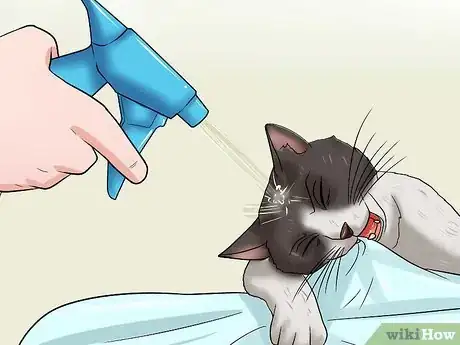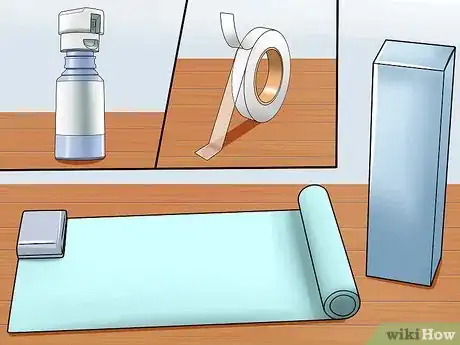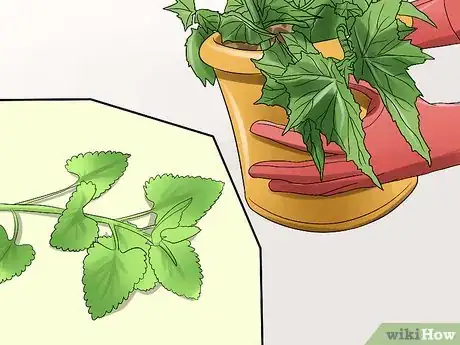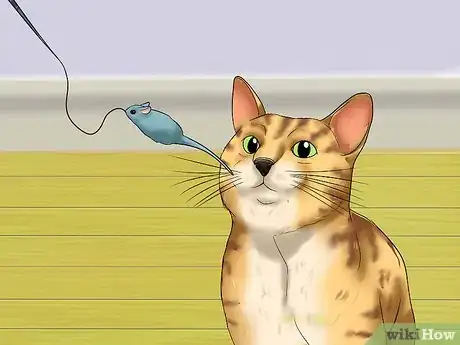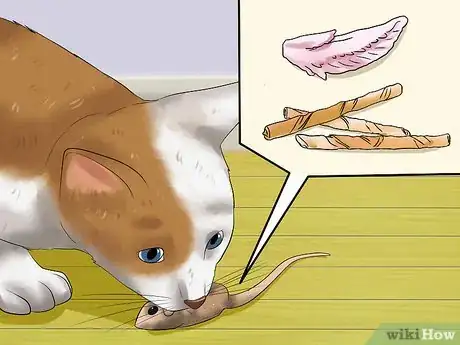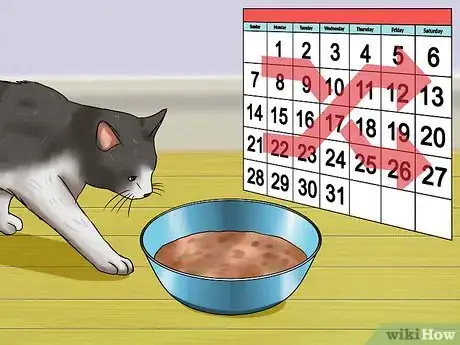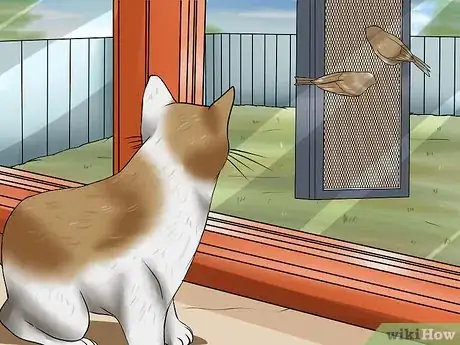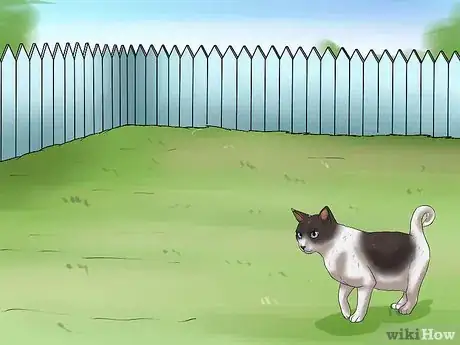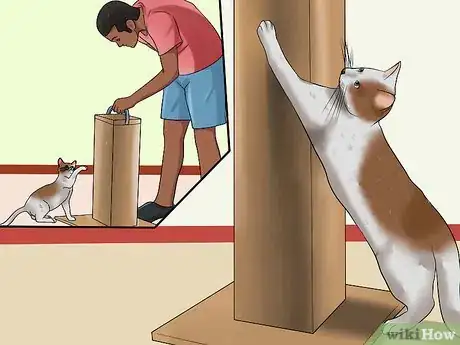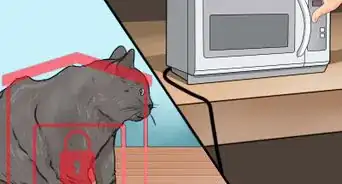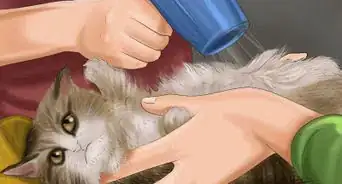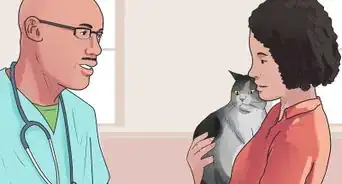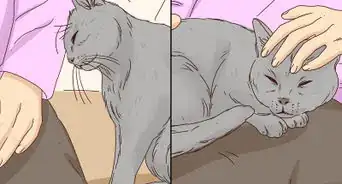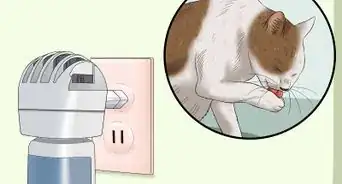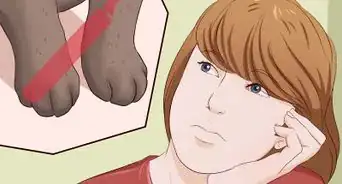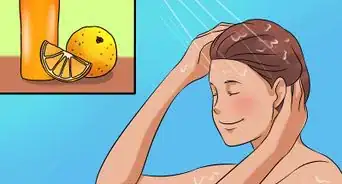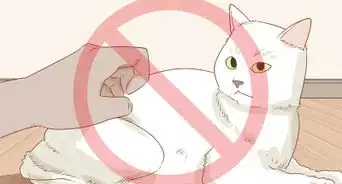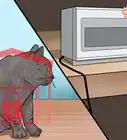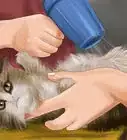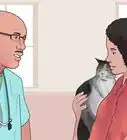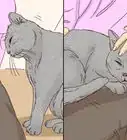This article was co-authored by Carrie Seay, MS-CABAC, KPA-CTP, CBCC-KA. Carrie Seay is a Feline Behavior Consultant and the Owner of Carrie Pawpins based in Phoenix, Arizona. With over a decade of experience, she specializes in working with cat owners to prevent and eliminate cat behavioral issues. Carrie holds a Bachelor’s degree in Biology from Northern Arizona University and a Master’s degree in Companion Animal Behavior Analysis & Counseling from The American College of Applied Science. She has multiple certifications from well-known training programs like Karen Pryor academy.
There are 11 references cited in this article, which can be found at the bottom of the page.
This article has been viewed 271,782 times.
Destructive chewing is usually an issue with dogs, but sometimes a cat is a chewer. While usually more of a nuisance, chewing electrical cords, toxic plants and containers with toxic chemicals, medications, and harmful human foods can cause big problems with a chewing cat. Barbering and over grooming are behavior issues when the cat destructively chews and licks at itself. It's important to work out why your cat chews, as well as to find a way to stop your cat from continuing this destructive behavior. By knowing the right approach, you can stop the chewing, whether your cat chews on itself or objects such as furniture or shoes.
Steps
Identifying Reasons Cats Chew
-
1Look for signs of compulsive chewing. A compulsion is an irresistible need to perform a certain behavior. In cat’s, the most common compulsive behaviors are wool or fabric sucking/chewing or excessive hair licking/chewing—also called psychogenic alopecia. This most often occurs when a cat is stressed or frustrated by something out of its control.[1] In kittens that are weaned too early, this can become a problem when they become adults. Generally a kitten should not be weaned from its mother before eight weeks of age.[2]
- Oriental breeds of cats are more likely to develop a compulsive chewing problem. Cats that are experiencing stress—such as moving to a new home or a new baby in the house—are also more at risk to develop a compulsive chewing problem.[3]
-
2See if the chewing is tied to playful behavior. Not all chewing is the result of a compulsive behavior. Young kittens and some adult cats may just be curious and adventurous enough to start chewing on things they shouldn’t. While it may be cute at first, this can be extremely dangerous if a kitten bites into an electrical cord or pulls a heavy object down on itself.[4]
- Boredom can also cause a cat to chew.[5]
Advertisement -
3Look for any associated medical conditions. Some chewing starts as the result of a medical condition, such as fleas, allergies, food intolerance, or an unhealed wound.[6] Dental disease or mouth sores may also cause a cat to chew on objects.[7]
- Even a behavior like chewing on a plant can have an associated medical explanation. Indoor cats especially with few grasses in their diet may simply chew on plants because they’re craving greens.[8]
-
4See your veterinarian. Before any diagnosing the reason behind any chewing behavior, your veterinarian should perform a thorough medical examination, especially on an adult cat that has recently started this behavior. Once your veterinarian has a diagnosis for the chewing behavior, then he or she will help you form a proper treatment plan.[9]
Controlling the Chewing Behavior
-
1Keep items the cat wants to chew out of its reach. This could mean putting clothing or fabrics into a closed closet, placing items on an unreachable shelf, or keeping the cat out of the room where you keep the chewed object.[10] If the cat has a problem with chewing electrical cords, then try placing a cord protector a rug, or even tape over the cords.[11]
-
2Use bad-tasting deterrents to stop the chewing. Some common solutions are bitter apple spray (a commercial preparation) or cayenne water (water with cayenne pepper in a spray bottle).[12] Always spot test the object you want to spray to make certain the spray doesn’t damage it.
-
3Use a spray bottle or small squirt gun with water in it to deter the cat. If you catch your cat chewing an object, immediately spritz the cat. Your cat will only associate the act with the negative consequence if you spritz the cat as it chews the object. If you can’t reach the spray bottle before the cat stops chewing, keep it next to you and wait until the next time the cat exhibits the behavior.
- A strong “no” at the same time will also help the cat learn that word.
-
4Booby trap the object. Since you can’t always be around with a spray bottle to deter the cat, you can set up a “trap” to deliver the negative consequence for you. For instance, you can place double-sided tape around the object. Cats detest the feel of sticky tape and will concentrate on that instead of the object.
- You can also look into products that deliver a repellant spray via a motion sensor.
- Another option is to place the object on a “scat mat,” which is a product that delivers an electrical tingle into the cat’s paws when it steps on it.
-
5Replace plants in the area with cat-friendly options. If a cat is chewing on a houseplant, it may enjoy the texture of the plant and want greens to chew on and eat.[13] Remove the chewed plant from the area and replace it with a more-appropriate option, such as oat grass, catnip, or catmint.[14]
- Make sure you especially move plants that would be toxic for the cat to chew. Some common examples include caladium, dumb cane, English ivy, lilies, mistletoe, oleanders, and philodendrons.[15]
-
6
Providing Enrichment to Reduce Boredom Chewing
-
1Play with your cat more. Since boredom can be one of the causes of chewing, try spending a little more time playing with your cat. With some additional stimulation, the cat might forget about the chewing altogether.[18] Try distracting your cat with dangling toys, a laser pointer, or other favorite toys.[19]
- Teach your cat recall behavior. When you see your cat going over to chew on something, call them over to you.[20]
-
2Give your cat appropriate objects to chew. Thin pieces of rawhide, toy mice, or food puzzle toys will help occupy your cat’s time.[21] An old bath towel or large stuffed toy can be a fun chew toy for certain cats. An uncooked chicken wing tip (the rubbery portion) may be appropriate for some cats as well.[22]
-
3Change your cat’s feeding schedule. Feed small, frequent meals in various places. Use food puzzles that provide enrichment and stimulation for a cat that chews out of boredom or stress.
-
4Mount bird feeders outside the window. Most cat owners know that cats can spend hours staring outside the window if the surroundings are exciting enough. Place a bird feeder (or even a squirrel feeder) outside an available window. The cat will be too enthralled with what’s going on outside to chew.[25]
-
5Consider taking your cat outside in a secure way. Don’t simply open the door and let an indoor cat roam free, but supervised time on an enclosed patio or in a fenced backyard is also enriching for your cat. Even just a few minutes outside chewing on some regular grass can prevent your cat from chewing once back indoors.[28]
- If you don’t have access to an enclosed outdoor space, you can also use a harness and a leash for your cat when playing outdoors.[29]
-
6Divert your cat’s attention with other solo activities. You can’t always be around to play with your cat or supervise it outdoors. The more solo activities you leave for the cat to occupy itself with, the more confident you can be that your cat isn’t chewing when you aren’t around. Consider providing:[30]
- A scratching post or cardboard scratch pads. You can also sprinkle the post or pads with catnip to make them even more irresistible to your cat.
- Dry treats hidden around your home. By hiding treats in a few different rooms that are accessible to the cat, you can ensure that your pet stalks around these rooms searching for the treats rather than spending time getting bored and chewing on something it shouldn’t.
Expert Q&A
-
QuestionHow do you stop a cat from chewing on furniture?
 Carrie Seay, MS-CABAC, KPA-CTP, CBCC-KACarrie Seay is a Feline Behavior Consultant and the Owner of Carrie Pawpins based in Phoenix, Arizona. With over a decade of experience, she specializes in working with cat owners to prevent and eliminate cat behavioral issues. Carrie holds a Bachelor’s degree in Biology from Northern Arizona University and a Master’s degree in Companion Animal Behavior Analysis & Counseling from The American College of Applied Science. She has multiple certifications from well-known training programs like Karen Pryor academy.
Carrie Seay, MS-CABAC, KPA-CTP, CBCC-KACarrie Seay is a Feline Behavior Consultant and the Owner of Carrie Pawpins based in Phoenix, Arizona. With over a decade of experience, she specializes in working with cat owners to prevent and eliminate cat behavioral issues. Carrie holds a Bachelor’s degree in Biology from Northern Arizona University and a Master’s degree in Companion Animal Behavior Analysis & Counseling from The American College of Applied Science. She has multiple certifications from well-known training programs like Karen Pryor academy.
Feline Behavior Consultant Find an appropriate toy for your cat to chew on that also has a wood base, like a silvervine stick. Ideally, you want to offer a replacement chew toy for the cat rather than stopping them from chewing altogether.
Find an appropriate toy for your cat to chew on that also has a wood base, like a silvervine stick. Ideally, you want to offer a replacement chew toy for the cat rather than stopping them from chewing altogether. -
QuestionMy cat destroys anything that is leather, vinyl, or plastic. He has damaged the hot pool cover and an ottoman. What should we do?
 Pippa Elliott, MRCVSDr. Elliott, BVMS, MRCVS is a veterinarian with over 30 years of experience in veterinary surgery and companion animal practice. She graduated from the University of Glasgow in 1987 with a degree in veterinary medicine and surgery. She has worked at the same animal clinic in her hometown for over 20 years.
Pippa Elliott, MRCVSDr. Elliott, BVMS, MRCVS is a veterinarian with over 30 years of experience in veterinary surgery and companion animal practice. She graduated from the University of Glasgow in 1987 with a degree in veterinary medicine and surgery. She has worked at the same animal clinic in her hometown for over 20 years.
Veterinarian Provide alternative toys as an outlet for his chewing behavior. Toys for small dogs may be appropriate, and consider using puzzle feeders to keep him mentally stimulated. Use cheese spread or peanut butter to make a Kong especially enticing, and the cat can chew on it lick out the treat. Provide plenty of scratching posts so the cat can vent his natural territory marking behavior, and play with him at least twice a day in order to burn off energy.
Provide alternative toys as an outlet for his chewing behavior. Toys for small dogs may be appropriate, and consider using puzzle feeders to keep him mentally stimulated. Use cheese spread or peanut butter to make a Kong especially enticing, and the cat can chew on it lick out the treat. Provide plenty of scratching posts so the cat can vent his natural territory marking behavior, and play with him at least twice a day in order to burn off energy. -
QuestionWhat can I do to stop a cat chewing the arms of my new couch?
 Pippa Elliott, MRCVSDr. Elliott, BVMS, MRCVS is a veterinarian with over 30 years of experience in veterinary surgery and companion animal practice. She graduated from the University of Glasgow in 1987 with a degree in veterinary medicine and surgery. She has worked at the same animal clinic in her hometown for over 20 years.
Pippa Elliott, MRCVSDr. Elliott, BVMS, MRCVS is a veterinarian with over 30 years of experience in veterinary surgery and companion animal practice. She graduated from the University of Glasgow in 1987 with a degree in veterinary medicine and surgery. She has worked at the same animal clinic in her hometown for over 20 years.
Veterinarian Set up a 'remote deterrent' so that when the cat approaches the couch arms, he gets a nasty surprise. The idea is to make him think the couch arms are possessed and scary, rather than linking any punishment to your presence. A motion-activated can of compressed air, sited beside the couch so it spritzes air when the cat jumps up, is one solution.
Set up a 'remote deterrent' so that when the cat approaches the couch arms, he gets a nasty surprise. The idea is to make him think the couch arms are possessed and scary, rather than linking any punishment to your presence. A motion-activated can of compressed air, sited beside the couch so it spritzes air when the cat jumps up, is one solution.
Warnings
- If your cat is chewing at itself all the time, you should take the cat to the vet immediately.⧼thumbs_response⧽
References
- ↑ Behavior Problems of the Dog and Cat. G. M. Landsberg, W. L. Hunthausen, L. J. Ackerman. Elsevier Health Sciences. 2012
- ↑ Domestic Animal Behavior for Veterinarians and Animal Scientists. Katherine A. Houpt. John Wiley & Sons. 2011
- ↑ Domestic Animal Behavior for Veterinarians and Animal Scientists. Katherine A. Houpt. John Wiley & Sons. 2011
- ↑ Behavior Problems of the Dog and Cat. G. M. Landsberg, W. L. Hunthausen, L. J. Ackerman. Elsevier Health Sciences. 2012
- ↑ http://www.humanesociety.org/animals/cats/cat_problem_solver/home.html?referrer=https://www.google.com/
- ↑ http://pets.webmd.com/cats/guide/cats-and-compulsive-scratching-licking-and-chewing
- ↑ http://pets.webmd.com/cats/guide/cats-and-compulsive-scratching-licking-and-chewing
- ↑ https://www.vet.cornell.edu/departments-centers-and-institutes/cornell-feline-health-center/health-information/feline-health-topics/feline-behavior-problems-destructive-behavior
- ↑ http://pets.webmd.com/cats/guide/cats-and-compulsive-scratching-licking-and-chewing
- ↑ Carrie Seay, MS-CABAC, KPA-CTP, CBCC-KA. Feline Behavior Consultant. Expert Interview. 1 March 2022.
- ↑ http://www.humanesociety.org/animals/cats/cat_problem_solver/home.html?referrer=https://www.google.com/
- ↑ http://www.humanesociety.org/animals/cats/cat_problem_solver/home.html?referrer=https://www.google.com/
- ↑ https://www.vet.cornell.edu/departments-centers-and-institutes/cornell-feline-health-center/health-information/feline-health-topics/feline-behavior-problems-destructive-behavior
- ↑ https://www.vet.cornell.edu/departments-centers-and-institutes/cornell-feline-health-center/health-information/feline-health-topics/feline-behavior-problems-destructive-behavior
- ↑ https://www.vet.cornell.edu/departments-centers-and-institutes/cornell-feline-health-center/health-information/feline-health-topics/feline-behavior-problems-destructive-behavior
- ↑ Veterinary Psychopharmacology. S. L. Crowell-Davis and T. Murray. John Wiley & Sons. 2008
- ↑ http://www.petsadviser.com/pet-health/why-is-my-cat-biting-his-fur-out/
- ↑ https://www.vet.cornell.edu/departments-centers-and-institutes/cornell-feline-health-center/health-information/feline-health-topics/feline-behavior-problems-destructive-behavior
- ↑ https://www.vet.cornell.edu/departments-centers-and-institutes/cornell-feline-health-center/health-information/feline-health-topics/feline-behavior-problems-destructive-behavior
- ↑ Carrie Seay, MS-CABAC, KPA-CTP, CBCC-KA. Feline Behavior Consultant. Expert Interview. 1 March 2022.
- ↑ Carrie Seay, MS-CABAC, KPA-CTP, CBCC-KA. Feline Behavior Consultant. Expert Interview. 1 March 2022.
- ↑ https://www.aspca.org/pet-care/virtual-pet-behaviorist/cat-behavior/compulsive-behavior-cats
- ↑ https://www.aspca.org/pet-care/virtual-pet-behaviorist/cat-behavior/compulsive-behavior-cats
- ↑ https://www.aspca.org/pet-care/virtual-pet-behaviorist/cat-behavior/compulsive-behavior-cats
- ↑ http://pets.webmd.com/features/keeping-indoor-cat-happy
- ↑ http://pets.webmd.com/features/keeping-indoor-cat-happy
- ↑ https://www.vet.cornell.edu/departments-centers-and-institutes/cornell-feline-health-center/health-information/feline-health-topics/feline-behavior-problems-destructive-behavior
- ↑ http://pets.webmd.com/features/keeping-indoor-cat-happy
- ↑ http://pets.webmd.com/features/keeping-indoor-cat-happy?page=2
- ↑ http://pets.webmd.com/features/keeping-indoor-cat-happy?page=2
About This Article
To stop your cat from chewing on something, mix some cayenne pepper and water in a spray bottle and spray it on the object so it will have an unpleasant taste. You can also try placing some double-sided tape around the object, which will scare your cat away when it tries to go near it. Keep in mind that your cat might be chewing because it's bored. To stop this, give your cat plenty of toys to chew on, like a large stuffed toy or an old towel, and make sure you play with it every day using things like a dangling toy or laser pointer. To learn how to tell if your cat's chewing might be related to a medical issue, keep reading.
